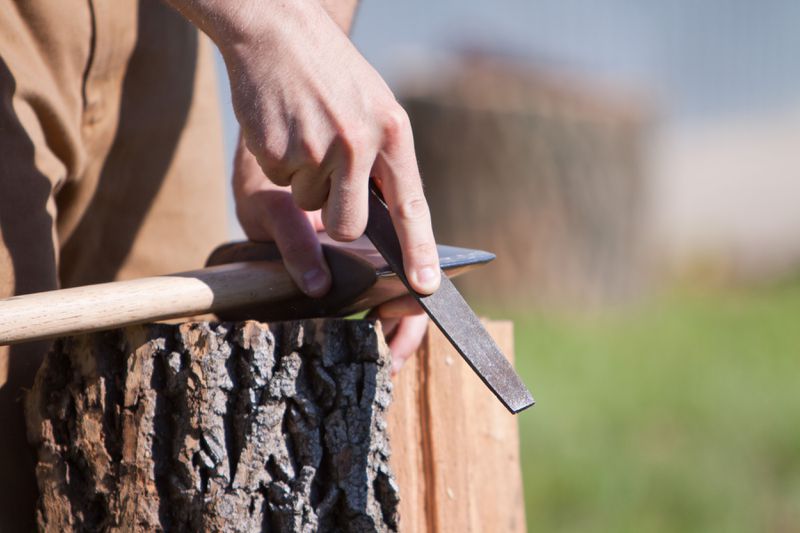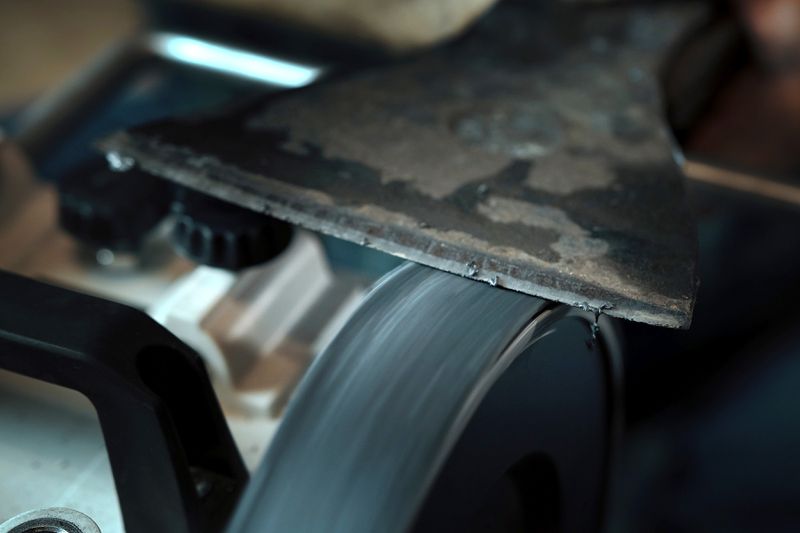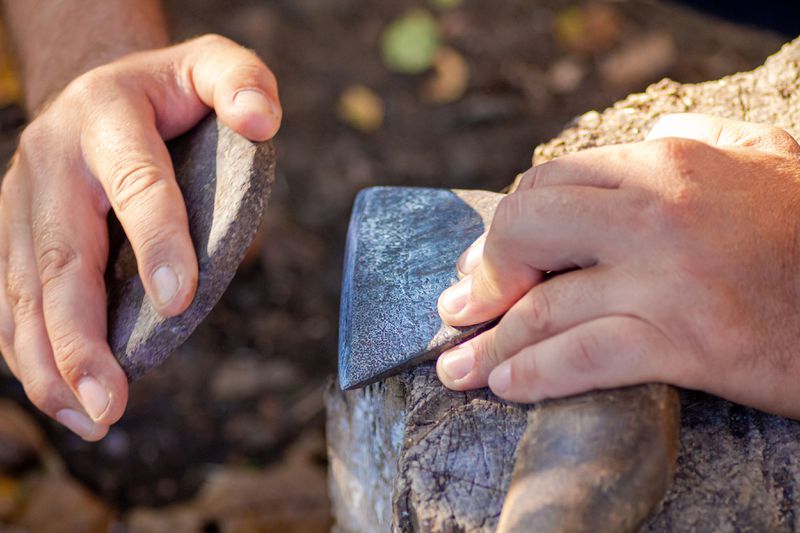How to Sharpen an Axe

>

Adobe
Cutting quickly and efficiently with an axe requires a sharp edge. Learn several methods to sharpen your axe with this step-by-step guide.
Axe sharpening is somewhat of a lost art, but learning to sharpen an axe can be a worthwhile skill. The lumberjacks of old would spend their lunch breaks sharpening their axes because they knew they could work faster, more efficiently, and with less effort if their edges were sharp.
The same applies to the work done around a property or job site. Sharp is always good, and with a bit of practice, you’ll be able to repair and sharpen any axe or hatchet bit (the blade of an axe) in no time.
How Sharp Should an Axe Be?
First, understand that axes don’t need to be razor-sharp. In fact, a razor-sharp edge can be more prone to chipping than a standard sharp edge. An axe must simply be sharp enough to slice through wood fibers, not so sharp that you can shave with it (though that often seems to be the test with internet axe-sharpening gurus). The idea is simply to create a sharp edge free of nicks and dents.
Also, there are several ways to sharpen an axe, and many folks proclaim that their method is the correct way. Unless you’re sharpening a $500 Swedish masterpiece of an axe (they do exist), any of the methods on this list will do.
How to Sharpen an Axe with a File

AlamyOne of the most common ways to sharpen an axe to a serviceable edge is with a file. The method is simple and the results are perfectly acceptable—especially for hardware store axes.
Tools and Materials
Bug and tar removerFile brushFlat work surfaceClamp
File>
Honing oil or beeswax>Work gloves
Step 1: Clamp the axe to a table
Sharpening an axe takes a lot of repetitive motion, so clamping it to a worktable offers the best result. Place the axe on its side so that the bit faces you and overhangs the table’s edge. Use the clamp to secure the handle to the table.
Step 2: Clean the axe head and file
Occasionally, axe heads will have a buildup of pitch and sap, which can clog the file. Use a bit of bug and tar remover or a similar cleaner to remove the pitch. Also, use a file brush or other stiff-bristled brush to remove any filings from the file.
Step 3: File one side of the axe
Don a pair of work gloves and begin passing the file over the edge of the axe, stroke by stroke. Try to match the blade’s bevel to avoid reshaping the grind (the technical term for the angle of the blade). Work left to right or right to left, but try to remain consistent. Also, files only remove metal while traveling in one direction, which is the push stroke. Pulling is counterproductive and will dull the file.
Once one side is sharp, flip the axe and clean the file.
Step 4: File the other side of the axe
Next, start sharpening the other side of the axe following the same method as above. Match the grind angle and push the file across the edge of the bit. Try to sharpen each side with the same number of strokes or for the same amount of time at the same general rate to ensure that the edge doesn’t move off-center and become chisel-like. If one side needs more work than the other, continue filing both sides evenly to maintain center.
Carefully check the edge of the axe to ensure that it’s sharp and free from nicks. Then lightly coat the axe head with a bit of oil or wax to protect it.
How to Sharpen an Axe with a Grinder

AdobeFor a quick, less-precise method of sharpening an axe, a bench grinder will do the trick. Just be sure to wear work gloves and safety glasses and avoid long hair and loose clothing that can get caught in the works.
Tools and Materials
Safety glassesBug and tar removerFile brushBench grinder
Honing oil or beeswax>Work gloves
Step 1: Clean the axe and grinding wheel
As mentioned earlier, axes often wear a bit of pitch or sap on their edges. Some bug and tar remover should do the trick. Also, if the grinding wheel is older, give it a quick brushing to remove any filings caught in the surface.
Step 2: Find the correct angle
Before firing up the grinder, take a few minutes to find an angle that works for your axe. Holding the axe so the head is against the rest, tip the bit upward until the angle of the edge on the underside of the blade is roughly parallel to the grinding wheel. If your grinder’s rest adjusts, match it to the axe head’s angle.
Hold the axe slightly back from the grinding wheel and start the grinder.
Step 3: Grind one side of the axe
Following the curve of the axe bit, sweep the edge of the bit across the grinding wheel, taking care to maintain a consistent angle. Make sure to keep the axe bit moving across the wheel to prevent flat spots in the grind and overheating the bit.
Step 4: Grind the other side of the axe
Remove the axe from the grinder and flip it over. If you’re comfortable, you can leave the grinder running and do your best to match the angle again (it isn’t an exact science). However, you can also shut the grinder off and wait for it to stop spinning to find the grind angle again.
Be sure to keep the axe edge moving across the grinding wheel.Match the amount of time spent grinding the second side to the time spent on the first side to keep the edge centered.Continue grinding one edge and then the other, checking for sharpness in between each pair of grinding sessions to maintain the centered edge. Axe sharpening with a grinder creates a rougher finish, but it should be free of nicks and dents. When finished, use a bit of oil or wax to protect the axe head.
How to Sharpen an Axe with a Sharpening Stone

AdobeThe most old-school of axe grinding methods is using a sharpening stone. These stones have two different grits, with a rough side for removing material and a fine side for refining the edge. Lumberjacks often keep these stones in their toolboxes or pouches and spit on them to create a bit of lubrication. We suggest using a few drops of honing oil but to each their own.
Tools and Materials
Bug and tar removerGrinding stoneHoning oil
Beeswax, if desiredWork gloves
Step 1: Clean the axe head
Grinding stones aren’t cheap, and they work best when they aren’t clogged with pitch, sap, and filings. To keep your grinding stone clear, clean the axe head before sharpening. Again, bug and tar remover will do the trick, but some WD-40 will also work.
Step 2: Oil the stone
A bit of honing oil helps lubricate the stone and keeps the edge of the axe cool during sharpening. A few drops are often all it takes, depending on how dry the stone is. Though you’ll be using both sides of the stone, oil just one side at a time. A light coat on the axe bit is also helpful.
Step 3: Sharpen one side of the axe with the rough side of the stone
Wearing work gloves, place the axe handle under one arm and point the bit in a comfortable direction. Use the rough side of the oiled stone to make circular passes across the bit. Unlike files, sharpening stones cut at several angles, so a circular motion works very well.
Be sure to keep your fingers from the edge of the stone to prevent cutting yourself on the axe’s edge. Also, do your best to maintain a consistent angle.
Step 4: Sharpen the other side of the axe with the rough side of the stone
Once satisfied, start sharpening the other side of the axe. Be sure to use small circular passes across the entire edge of the bit. Do your best to match the number of passes or time spent grinding this side to the time spent on the previous side to keep the edge centered.
Continue switching between sides until the edge is consistent and there are no nicks or dents. You might have to clean the grinding stone with a brush or some extra oil every so often.
Step 5: Use the fine side of the sharpening stone
With a few drops of oil on the fine side, repeat Steps 3 and 4. The fine side will refine the edge and bring it to a much sharper point. Generally speaking, one or two passes per side is usually all it takes to refine an axe edge since the rough grinding does most of the work.
After refining the edge, coat the axe head with oil or wax to protect the metal.
How Much Does it Cost to Sharpen an Axe?
With this guide, you should be able to sharpen an axe without issue. However, circumstances exist where someone might prefer not to sharpen their own axe. Luckily, there is a solution.
If you have an heirloom axe or don’t want to be bothered with sharpening, you can pay someone to sharpen an axe for you. Most professional services will charge between $5 and $10 an edge. The cost will be higher in some instances, including those involving special metals or tremendously damaged bits. If your handle needs replacing, most sharpening services will rehandle an axe for $20, plus the cost of the handle.
Did you miss our previous article…
https://www.tampa-bay-homes-guide.com/?p=1344
